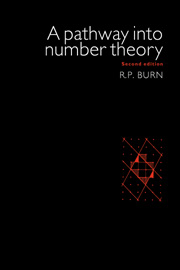Book contents
- Frontmatter
- Contents
- Preface to the second edition
- Introduction
- 1 The fundamental theorem of arithmetic
- 2 Modular addition and Euler's ɸ function
- 3 Modular multiplication
- 4 Quadratic residues
- 5 The equation xn + yn = zn, for n = 2, 3, 4
- 6 Sums of squares
- 7 Partitions
- 8 Quadratic forms
- 9 Geometry of numbers
- 10 Continued fractions
- 11 Approximation of irrationals by rationals
- Bibliography
- Index
- Frontmatter
- Contents
- Preface to the second edition
- Introduction
- 1 The fundamental theorem of arithmetic
- 2 Modular addition and Euler's ɸ function
- 3 Modular multiplication
- 4 Quadratic residues
- 5 The equation xn + yn = zn, for n = 2, 3, 4
- 6 Sums of squares
- 7 Partitions
- 8 Quadratic forms
- 9 Geometry of numbers
- 10 Continued fractions
- 11 Approximation of irrationals by rationals
- Bibliography
- Index
Summary
Subgroups of a square lattice
1 In fig. 9.1, a rectangular lattice has been superimposed upon a square lattice. Take a point common to the two lattices as origin, and label the points of the square lattice with the elements of Z × Z = Z2, in the usual way. Name the points of the rectangular lattice and, supposing that it extends to infinity, show that the points of the rectangular lattice form a subgroup of Z2 under vector addition. Name a pair of generators for this subgroup.
Throughout this chapter, it should be presumed that the underlying square lattice has been labelled with the set Z2 and that a point common to such lattices as are under discussion has been chosen as origin.
2 In fig. 9.2, find the coordinates of the points of the parallelogram lattice superimposed on Z2, and show that these points form a subgroup of Z2 under vector addition. Name a pair of generators for this subgroup.
3 In fig. 9.3, find the coordinates of the parallelogram lattice superimposed on Z2, and show that these points form a subgroup of Z2 under vector addition. Name a pair of generators for this subgroup.
4 Give reasons why any parallelogram lattice of points of Z2 forms a subgroup of Z2, provided that the origin is common to both lattices.
5 If A and B are points of Z not collinear with the origin O, then the four points O, A, B and A + B are the vertices of a
parallelogram, which we call a fundamental parallelogram of the sub group (A, B). Find the area of a fundamental parallelogram of each of the subgroups of q 1, q 2 and q 3.
6 Identify the cosets of the subgroups of q 1, q 2 and q 3.
7 where, is a translation of the lattice Z2. If G is a subgroup of Z2 forming a parallelogram lattice, r is said to be a translation of G whenever.
- Type
- Chapter
- Information
- A Pathway Into Number Theory , pp. 187 - 213Publisher: Cambridge University PressPrint publication year: 1996



